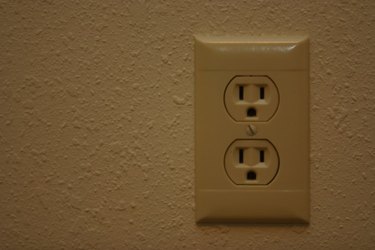
Outlet circuits consist of a breaker in the electrical panel that feeds power to all of the outlets on that single circuit. The number of outlets on a circuit is usually limited by the local authority with jurisdiction, such as a city, county or state. The electrical wire usually runs from the breaker panel to the closest outlet on the circuit, known as the home-run box. From there, wires run to other outlets on the circuit. Testing which outlets are on the same breaker circuit requires turning off the breaker that feeds power into an outlet and checking whether or not other outlets still have power.
Step 1
Plug one lamp into one of the outlets that you want to test. Turn on the lamp. Go to the electrical panel, and turn off the breaker that you think controls power to that outlet.
Video of the Day
Step 2
Check whether or not the lamp's light is off to verify you turned off the correct breaker for that circuit. With the breaker controlling the lamp's outlet turned off and all other breakers in the electrical panel still in the on position, all outlets that have no power are on the same circuit as the lamp's outlet.
Step 3
Plug the lamp into another outlet to determine whether or not that outlet is on the same circuit. If the lamp lights with the breaker still off, then the outlet is on a different circuit. If the lamp doesn't light, then it is on the same circuit as the original outlet.
Video of the Day